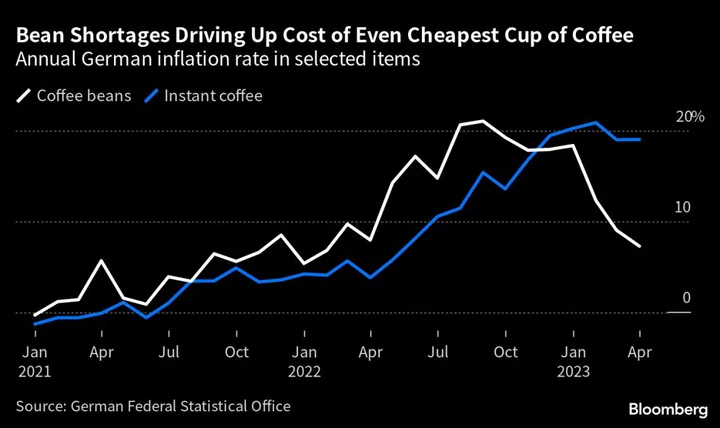The global cost-of-living crunch has pushed coffee drinkers to get their fix from cheaper brews. But a shortage of robusta beans is making it increasingly difficult to find a budget-friendly cup.
While many coffee lovers prefer the high-quality arabica beans sold in cafes, robusta is normally less expensive because the tree is hardier and requires less care, making it easier to produce in large quantities. The variety is often used in instant coffee, espressos and ground blends sold at supermarkets, which have experienced a comeback as cash-strapped consumers seek alternatives.
Key growers, however, are finding it difficult to keep up with the surge in demand, with wholesale prices this week hitting the highest level in nearly twelve years.
For consumers in Europe’s largest coffee market, Germany, the squeeze is having a noticeable effect on retail costs, with instant varieties going for nearly 20% more than a year ago, even as inflation for coffee beans has lost momentum. US instant coffee price-growth also slowed less than the roasted version in April.
The odds of global robusta shortages easing any time soon look bleak. Vietnam — the world’s largest producer — probably collected its smallest harvest in four years, after farmers focused on planting more profitable crops like avocados and durians to cope with booming fertilizer costs in the aftermath of Russia’s invasion of Ukraine.
Brazil, the second-largest grower of the variety, has seen its crops hurt by drought, and there are also concerns that Indonesia’s output could suffer following heavy rains.
Despite those hurdles, more robusta beans were exported globally in the first six months of the current season compared to the last three years — just not fast enough to keep up with higher needs. Shipments between October and March were about 4% higher than the same period in 2021-22, according to the International Coffee Organization.
“There’s been so much of a demand shift away from higher-priced coffee that even the market isn’t even being satisfied by higher robusta exports,” said Judith Ganes, who runs a consultancy focused on commodities like coffee in New York.
The switch was first observed among roasters who increased the amount of robusta used in commercial blends to offset higher arabica costs and energy bills. Then, double-digit inflation in many parts of the world saw grocery bills surge to the highest in decades, forcing some consumers to trade down to cheaper options.
As a result, robusta-heavy instant coffee is growing faster than other industry segments, according to Aguinaldo Lima of the Brazilian Instant Coffee Industry Association, whose country is the world’s top soluble coffee producer. And leading companies elsewhere, such as Nestle SA and India’s Tata Coffee, have also reported stronger demand for instant coffee in their latest financial reports.
While robusta beans are known to be significantly more bitter than the arabica variety — in part due to higher levels of caffeine — Vietnam and Indonesia have both improved the quality of their beans, making it easier for roasters to increase the variety in blends without drastically affecting the taste, according to Ganes.
Consumers might discover “very interesting flavors” by drinking robustas, even if the taste is different than arabica coffee, said Daniel Munari, a barista who also runs Royalty Quality Cafe in southern Brazil.
“There’s sweetness and acidity, which are a great addition and give balance to the drink,” he said.
Author: Mumbi Gitau, Dayanne Sousa and Mai Ngoc Chau

